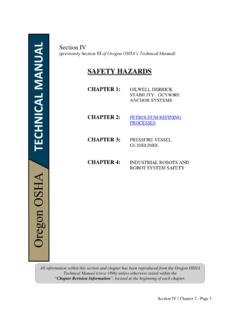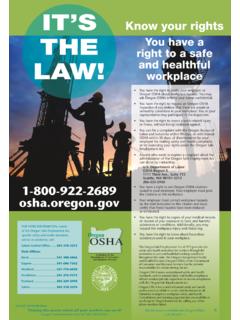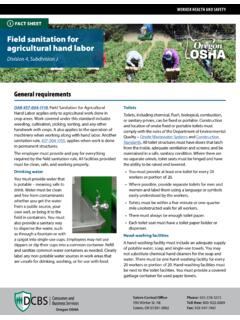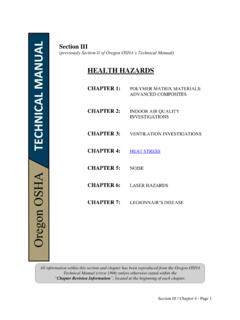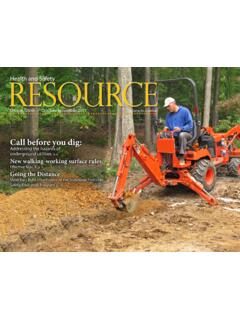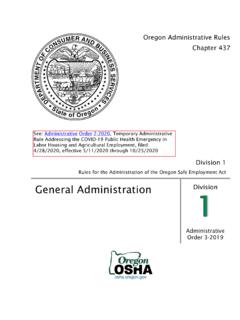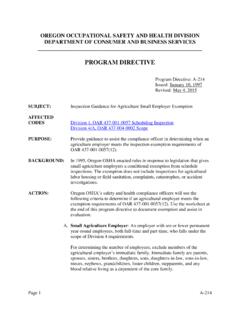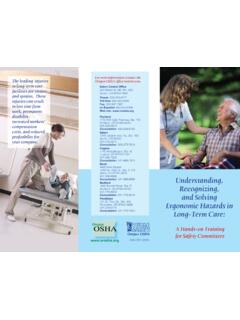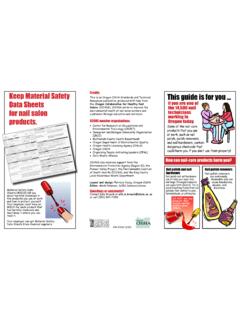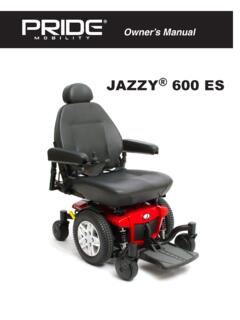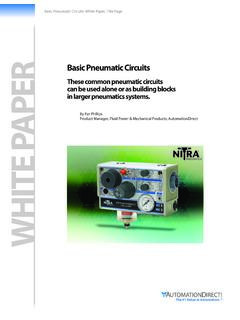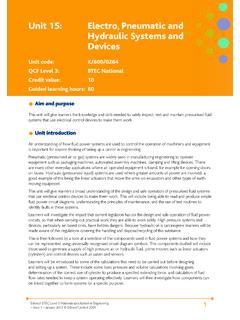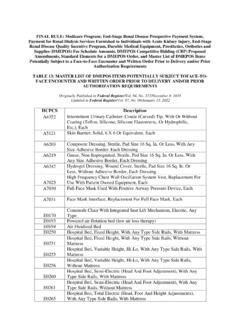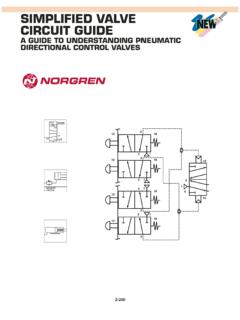Transcription of Lockout/Tagout Oregon OSHA's guide to controlling ...
1 WORKER HEALTH AND SAFETYO regon OSHAL ockout/TagoutOregon OSHA s guide to controlling hazardous Oregon OSHA s guide to controlling hazardous energyAbout this guide Lockout/Tagout is an Oregon OSHA Standards and Technical Resources Section noticeReprinting, excerpting, or plagiarizing this publication is fine with us as long as it s not for profit! Please inform Oregon OSHA of your intention as a of Contents Introduction ..1 What you will learn from this guide ..1 Understanding energy ..1 Energy and motion ..1 Forms of energy ..2 How energy becomes hazardous ..2 Hazardous energy in the workplace can kill.
2 3 controlling hazardous energy ..3 Identifying energy sources and energy-isolating devices ..3De-energizing equipment ..4 Secure energy-isolating devices in a safe position ..5 Dissipate or restrain potential energy that can t be isolated ..5 Verify equipment isolation ..6 Lockout, tagout, or Lockout/Tagout ? How to decide ..6 Facts about lockout and tagout devices ..7 Your energy control program ..7 Develop your written energy control procedures ..7 Train your employees ..8 Perform periodic inspections ..9 Putting it all together ..10 Common questions ..10 Traditional lockout vs.
3 Group lockout ..12 Working by the rules ..13 Definitions ..14 Oregon OSHA services ..151 IntroductionEnergy surrounds us as we work. Energy is critical in every place of business. Energy that is unexpected may be hazardous. Hazardous energy may be obvious, but often is not. Hazardous energy threatens if you do the following: `Service or maintain equipment that could unexpectedly start or move. `Work near equipment when it s being serviced. `Remove or go around machine guards. `Fail to follow established energy control guide is based on the requirements in Oregon OSHA s standard for hazardous energy control Subdivision 2/J, , which protects employees who could be injured as a result of the unexpected release of hazardous energy.
4 The requirements apply when an employee doing service or maintenance on a machine or equipment could be injured by the unexpected startup or release of hazardous energy. Lockout (LO) and tagout (TO) are the primary methods of controlling hazardous or maintenance includes erecting, installing, constructing, repairing, adjusting, inspecting, unjamming, setting up, troubleshooting, testing, cleaning, and dismantling machines, equipment, or processes. In this guide , equipment means equipment and machines, whether fixed or you will learn from this guide `Why you should be concerned about hazardous energy.
5 `Safe practices for controlling hazardous energy. `Key requirements of Oregon OSHA s hazardous-energy-control standard Subdivision 2/J, : This guide will help you understand how to control hazardous energy and meet the requirements of 1910 .147, but it does not take the place of 1910 .147 .Understanding energyEnergy and motionEnergy is the power for doing work. Energy exists in different types (see Page 2), but all are associated with motion. Regardless of the type, energy exists in two basic states: potential energy and kinetic energy. Tensioned objects such as suspended loads have potential energy energy that has the opportunity for motion.
6 Releasing the load converts potential energy to kinetic energy, causing the load to forklift truck, raised for repair work, has potential forklift truck uses kinetic energy to raise/lower its of energyPotentialStored energy that can be drawn upon to do work. Potential energy can be viewed as motion waiting to happen based on an object s position, such as the energy found in elevated, suspended, compressed, or coiled materials. Potential energy can be converted to kinetic energy to do resulting from moving objects, such as released loads, uncoiling springs, and moving machinery.
7 When these objects are released, their potential energy is converted to kinetic energy. Types of energyChemicalLiquids, such as gasoline, diesel, benzene, acids, and caustics. Gases, such as propane, natural gas, and methane. Solids, such as fertilizer, wet and dry cell batteries, and combustible (AC) and direct (DC) currents. Includes equipment and conductors at both household and industrial voltages, photovoltaic systems, circuit breakers, transformers, capacitors, inverters, motors, and hybrid such a hoisted vehicles, raised dumpster lids, objects supported by a crane, and elevated dump truck hydraulic systems, including hoses, pumps, valves, actuators, and reservoirs such as those on a forklift, in an automotive vehicle hoist, power press equipment, or an injection molding such as a breeze rotating a wind turbine, water moving a paddle wheel, vehicle/mobile equipment movement.
8 And a spring under compression. Extreme sound is also a hazardous mechanical air or gas systems, including pipes, pumps, valves, actuators, and pressure vessels such as those found in coating or pesticide sprayers, air compressors, and tank and pipe purging light, infrared, microwave, ultraviolet, and X-rays. Non-ionizing radiation includes lasers, radio frequency (RF), and microwave (MW). Ionizing radiation includes computed tomography (CT) and water, heated oil, steam, and equipment need time to cool, while liquefied gases, such as nitrogen, need time to warm to safe thermal Transformation Energy is often converted from one type to another to make it more useful.
9 Chemical energy stored within a fuel such as natural gas is released as thermal energy when it is burned at a power plant. This thermal energy is used to heat water within a boiler to create steam, which expands to rotate a turbine, generating electricity. The electrical energy is then distributed along power lines to businesses where the electricity can be used to power an air compressor. The compressor s electric motor forces ambient air into a pressure vessel, confining large amounts of air into a small space for future use. This stored air is pneumatic potential energy that can be used at a later time.
10 During an electrical power failure, you can still use an air-powered tool, as long as sufficient potential pneumatic energy (compressed air) remains within the air compressor s pressure vessel to operate the energy becomes hazardousEnergy becomes hazardous when it builds to a dangerous level or is released in a quantity that could injure a worker. Hazardous energy is never far from those who need to service or maintain equipment. Simply turning the power off does not make the equipment safe! It is critical that those who service or repair equipment know how hazardous energy could harm them and how to control hazardous energyTo control hazardous energy, you must prevent it from being transmitted from its source to the equipment that it powers.

